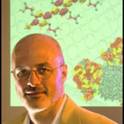
Selective surface recognition by proteins provides programmed bottom-up assembly of synthetic nanomaterials. We have investigated the controlled self-assembly of functionalized gold nanoparticles (Au-TAsp) with cytochrome c (Cyt c) and apoCyt c through complementary electrostatic interactions. Au-TAsp formed discrete, water-soluble adducts with native Cyt c, whereas unfolded apoCyt c induced nanocomposite formation at high Cyt c : Au-TAsp ratios. The binding of random-coil apoCyt c to Au-TAsp at low ratios induced α-helix formation in soluble nanocomposites, but at elevated ratios insoluble micron-scale aggregates were formed. The local structure of the assemblies was critically dependent on the Cyt c : Au-TAsp ratio. The dispersibility of apoCyt c–Au-TAsp was pH dependent, providing rapid and reversible control over nanocomposite assembly. The apoCyt c–Au-TAsp aggregates could likewise be disassembled through proteolytic cleavage of apoCyt c, demonstrating the ability to selectively remodel these hybrid materials.
Available at: http://works.bepress.com/vincent_rotello/54/
